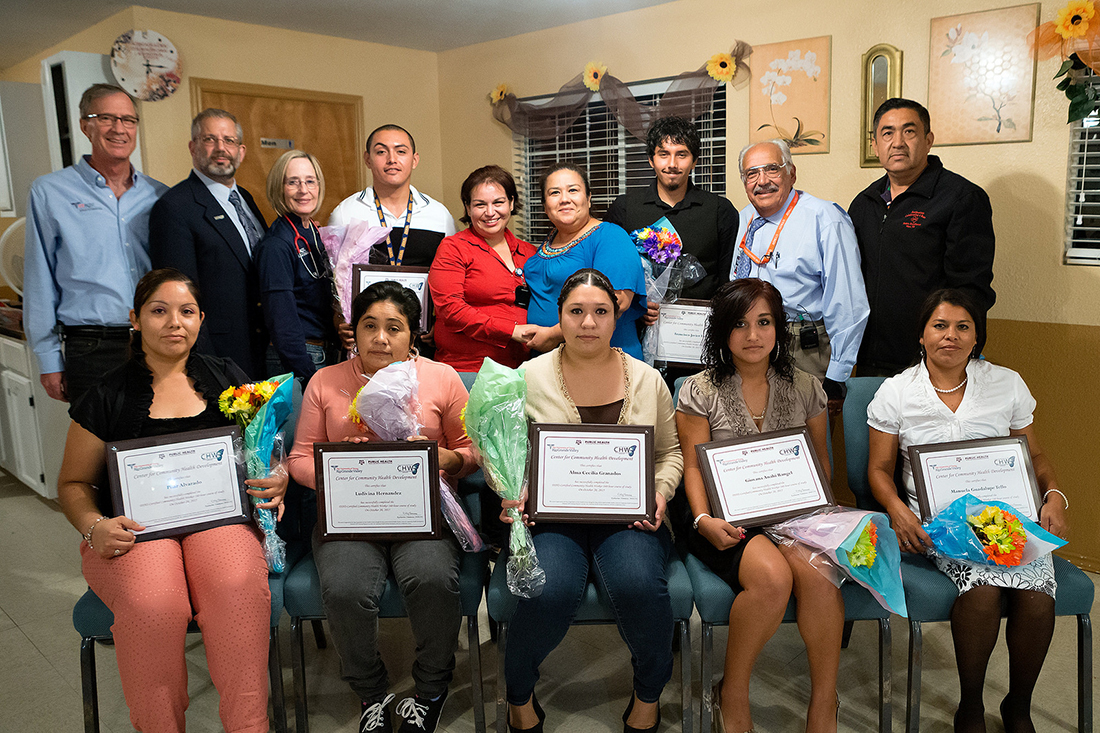
Members of the first graduating class of health care promoters are shown with UTRGV and Texas A&M University officials after they received their certificates of completion during a ceremony Nov. 17. They are (seated, from left) Pilar Alvarado, Ludivina Hernandez, Alma Cecilia Granados, Giovana Anahi Rangel and Manuela Guadalupe Tello. Back row: John Ronnau, UTRGV senior associate dean for Interprofessional Education; Eron Manusov, founding chair of the UTRGV School of Medicine’s Family and Community Medicine department and assistant dean of Education and Clerkships; Linda Nelson, UTRGV School of Medicine senior director of Clinical Operations; Jesus Enrique Delgado, health care promoter graduate; Ernestina Constante, community health worker for the Texas A&M University Health Science Center; Paula Saldaña, promotora and trainer; Francisco Javier Escalon, health care promoter graduate; Francisco Fernandez, founding dean of the UTRGV School of Medicine; and Juan Moreno, pastor of La Iglesia de los Hechos. PHOTO COURTESY PAUL CHOUY
At age 42, Guadalupe Tello believed she could not go back to school. Then, she heard about a health promoter program.
“I thought, ‘That’s it, I can’t study anymore,’” Tello said in Spanish. “So, when I was introduced to this program I thought, ‘I can do it. I can try it.
This is a challenge for my life.’”
She was part of the first class of health promoters, also known as promotores, in the Indian Hills community in Hidalgo County. The program is a result of the partnership between the University of Texas Rio Grande Valley and the Texas A&M University School of Public Health.
The first class, which consisted of seven students, graduated on Nov. 17 during a ceremony at La Iglesia de los Hechos in Indian Hills. Each graduate received a certificate of completion that authorizes them to apply for state certification.
After submitting their applications, students will receive their certificates by mail within four weeks.
Tello said she was introduced to the program when Hidalgo County hosted health clinics in her church. Once she receives
her certification, she plans to help and inform the people of her community by participating in the same health clinics.
“A community health worker, or promotora, is a liaison between the community and the health care system,” said Paula Saldaña, a health promoter instructor for the Center for Community Health Development in the School of Rural Public Health at the Texas A&M University Health Science Center.
A community health worker can also be considered part of the healthcare team, just like nurses and doctors, Saldaña said.
“A lot of the community health workers have dealt with issues the community is dealing with currently, and they’ve been
able to go over obstacles and challenges,” she said.
Eron Manusov, chair of the School of Medicine’s Family and Community Medicine department, said health promoters are the link between health care and the community.
“[Health promoters] have been very successful all over the world to get health care into the communities,” Manusov said. “If I tell you to do something, you may not listen to me, but if a promotora, which happens to be your aunt or somebody in the community tells you, you’re more likely going to listen. So, they’re the bond to the community.”
Saldaña said that in Texas the average health promoter earns between $8 and $15 an hour, depending on the city and company they work for.
To be a health promoter in Texas, one has to be a Texas resident, at least 18 years of age and complete a 160-hour
course through a credentialed teaching program.
“That is why we partnered with TAMU because they are the only teaching credentialed center,” Manusov said.
“With this program, we’re building a credentialed teaching program down here so that we don’t have to go anywhere
else to do our training.”
The program is funded by the United Health Foundation and is part of the UTRGV School of Medicine’s South Texas Interprofessional Team Collaborative for Health (STITCH), which includes collaborators from multiple locations across the nation. Hospitals, nonprofit groups and other educational institutions are also teaming up with the program in
order to provide care for communities.
In addition to certifying individuals to be health promoters, STITCH will offer a service for already certified promoters to continue their education, specializing in mental health. The third part would allow individuals to achieve college credit through the program.
The course fee is $600 for community health worker and $1,000 for community health worker instructor. Fees vary for
continuing education courses. Classes are conducted online or in person based on demand. For more information, visit nchwtc.tamhsc.edu.






